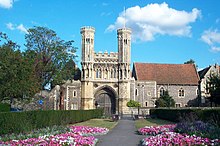St Augustine's Abbey

St Augustine's Abbey is a ruined abbey in Canterbury, Kent, England.
Early history
In the year 598, Saint Augustine was sent to England by Pope Gregory I, on what might nowadays be called a revival mission. King of Kent at this time was Ethelbert, who happened to be married to a Christian, Bertha. Whether or not his spouse influenced him, he allowed Augustine to found a monastery just outside the walls of Canterbury. Already standing on the site were three Saxon churches, dedicated respectively to Saints Pancras, Peter and Paul, and finally Mary. The Saxon-phase remains of the church of Saint Pancras are still extant, however, the other two churches were rebuilt by the Normans into one building. One of the main purposes of the abbey right from the outset was as a burial place for the Kings of Kent and the Archbishops of Canterbury. In 978 a new larger building was dedicated by Archbishop Dunstan, to the Saints Peter, Paul, and Augustine.
12th century
By 1100 all remains of the original Anglo Saxon building had disappeared under a massive romanesque edifice, to which an Almonry was added in 1154. Apart from some rebuilding work in 1168 as a result of a fire, the rest of the 12th century passed fairly quietly at the abbey.
13th century
However from about 1250 onwards the abbey was once again alive with building work. The cloister, lavatorium, frater and kitchen were totally rebuilt and a grand new abbot's lodging was built. The range was also extended to provide a great hall.
14th century
A new crenellated Great Gate was built in 1309 completing the Inner Court. On the north side the monks were able to take in much more land, which provided space for a new outer court with cellarer's range, brewhouse, bakehouse, and in 1320 a new walled vineyard. There was also expansion on the east side of the abbey where a series of lodgings were built along with a walled cellarer's garden. An earthquake in 1382 meant more building work, and in 1390 the gatehouse that still survives was built. The last thing to be built was a Lady Chapel, to the east of the church.
By 1500 the abbey covered a very large area, and its library contained in excess of 2000 volumes, a staggering number for the time. Many of these would have been produced in the abbeys own scriptorium.
Dissolution
In 1535, the abbey was valued, and found to have a gross income of £1733. On July 30 1538, the abbey's fate was sealed when it fell to the dissolution of Henry VIII. The abbey was systematically dismantled over the next fifteen years, although part of the site was converted to a palace, ready for the arrival of Anne of Cleves, from France.
Modern history
This palace was leased to a succession of nobles, and in the early 1600s was in the possession of Edward Lord Wotton, who employed John Tradescent, to lay out formal gardens around it. This palace is thought to have survived until a great storm in 1703, which certainly caused great damage to the already ruinous structure of the abbey.
Now a World Heritage Site, the ruins of this important monastic foundation built by Saint Augustine are in the care of English Heritage.
Today the ruin precincts cover a substantial area east of the cathedral, and in fact, in its heyday the church rivalled the nearby Canterbury Cathedral in size.

